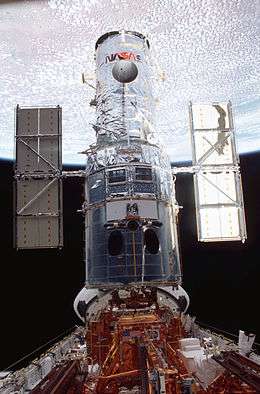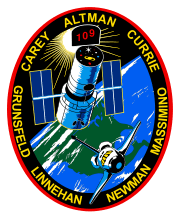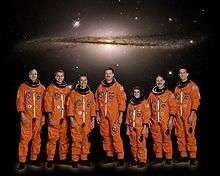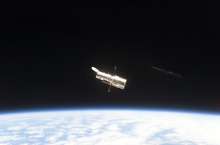STS-109
 Hubble in Columbia's payload bay towards the end of the mission | |||||
| Mission type | Hubble servicing | ||||
|---|---|---|---|---|---|
| Operator | NASA | ||||
| COSPAR ID | 2002-010A | ||||
| SATCAT № | 27388 | ||||
| Mission duration | 10 days, 22 hours, 11 minutes, 09 seconds | ||||
| Distance travelled | 6,300,000 kilometres (3,900,000 mi) | ||||
| Orbits completed | 165 | ||||
| Spacecraft properties | |||||
| Spacecraft | Space Shuttle Columbia | ||||
| Launch mass | 116,989 kg (257,917 lb) | ||||
| Landing mass | 100,564 kg (221,706 lb) | ||||
| Crew | |||||
| Crew size | 7 | ||||
| Members |
Scott D. Altman Duane G. Carey John M. Grunsfeld Nancy J. Currie Richard M. Linnehan James H. Newman Michael J. Massimino | ||||
| Start of mission | |||||
| Launch date | 1 March 2002 11:22:02 UTC | ||||
| Launch site | Kennedy LC-39A | ||||
| End of mission | |||||
| Landing date | 12 March 2002 09:33:10 UTC | ||||
| Landing site | Kennedy SLF Runway 33 | ||||
| Orbital parameters | |||||
| Reference system | Geocentric | ||||
| Regime | Low Earth | ||||
| Perigee | 486 km (302 mi) | ||||
| Apogee | 578 km (359 mi) | ||||
| Inclination | 28.5 degrees | ||||
| Period | 95.3 minutes | ||||
  (L-R): Michael J. Massimino, Richard M. Linnehan, Duane G. Carey, Scott D. Altman, Nancy J. Currie, John M. Grunsfeld and James H. Newman.
| |||||
STS-109 (SM3B) was a Space Shuttle mission that launched from the Kennedy Space Center on 1 March 2002. It was the 108th mission of the Space Shuttle program,[1] the 27th flight of the orbiter Columbia[1] and the fourth servicing of the Hubble Space Telescope.[2] It was also the last successful mission of the orbiter Columbia before the ill-fated STS-107 mission, which culminated in the Columbia disaster.
The Hubble Space Telescope (HST) was placed in orbit during mission STS-31 on 25 April 1990.[3] Initially designed to operate for 15 years, plans for periodic service and refurbishment were incorporated into its mission from the start.[4] After the successful completion of the second planned service mission (SM2) by the crew of STS-82 in February 1997, three of HST's six gyroscopes failed. NASA decided to split the third planned service mission into two parts, SM3A and SM3B.[5] A fifth and final servicing mission, STS-125 (SM4) launched 11 May 2009[6] The work performed during SM4 is expected to keep HST in operation through 2014.[7]
Crew
| Position | Astronaut | |
|---|---|---|
| Commander | Scott D. Altman Third spaceflight | |
| Pilot | Duane G. Carey First spaceflight | |
| Mission Specialist 1 | John M. Grunsfeld Fourth spaceflight | |
| Mission Specialist 2 | Nancy J. Currie Fourth spaceflight | |
| Mission Specialist 3 | Richard M. Linnehan Third spaceflight | |
| Mission Specialist 4 | James H. Newman Fourth spaceflight | |
| Mission Specialist 5 | Michael J. Massimino First spaceflight | |
Spacewalks

| EVA | Team | Start – UTC | End – UTC | Duration |
|---|---|---|---|---|
| 1 | Grunsfeld Linnehan |
4 March 2002, 06:37 | 4 March 2002, 13:38 | 7:01 |
| 2 | Newman Massimino |
5 March 2002, 06:40 | 5 March 2002, 13:56 | 7:16 |
| 3 | Grunsfeld Linnehan |
6 March 2002, 08:28 | 6 March 2002, 15:16 | 6:48 |
| 4 | Newman Massimino |
7 March 2002, 09:00 | 7 March 2002, 16:18[8][9] | 7:18 |
| 5 | Grunsfeld Linnehan |
8 March 2002, 08:46 | 8 March 2002, 16:18[8][10] | 7:32 |
Mission highlights

The purpose of STS-109 was to service the Hubble Space Telescope (HST). It was Columbia's first flight following an extensive two and a half year modification period (its most recent mission being STS-93). During the mission the crew installed a new science instrument, the Advanced Camera for Surveys (ACS), new rigid solar arrays (SA3), a new Power Control Unit (PCU) and an experimental cryocooler for the Near Infrared Camera and Multi-Object Spectrometer (NICMOS). Columbia also reboosted HST to a higher orbit.
The STS-109 astronauts performed a total of five spacewalks in five consecutive days to service and upgrade the Hubble Space Telescope. The spacewalkers received assistance from their crewmates inside Columbia. Currie operated the Shuttle's robot arm while Altman was her backup. Carey and Altman documented the EVA activities with video and still images.
Accomplishments of the spacewalks included the installation of new solar arrays, a new camera, a new Power Control Unit, a Reaction Wheel Assembly and an experimental cooling system for the NICMOS unit. STS-109 accumulated a total of 35 hours, 55 minutes of EVA time. Following STS-109, a total of 18 spacewalks had been conducted during four Space Shuttle missions to service Hubble (the others being STS-61, STS-82, STS-103 and STS-125) for a total of 129 hours, 10 minutes by 14 different astronauts.

It was also the last successful flight of Columbia, as on its next mission, STS-107, it disintegrated on re-entry, killing all aboard.
STS-109 is considered a night launch, as sunrise was at 6:47 am, and Columbia launched at 6:22 am EST, 25 minutes before sunrise.
| Attempt | Planned | Result | Turnaround | Reason | Decision point | Weather go (%) | Notes |
|---|---|---|---|---|---|---|---|
| 1 | 21 Feb 2002, 10:22:00 am | Scrubbed | --- | Mission replanning[11] | |||
| 2 | 28 Feb 2002, 6:48:00 am | Scrubbed | 6 days, 20 hours, 26 minutes | Technical | 21 Feb 2002, 10:00 am | 60% | Wrong bearings installed on Columbia's main landing gear[12] |
| 3 | 1 Mar 2002, 6:22:02 am | Success | 0 days, 23 hours, 34 minutes | [13] |
See also
References
![]() This article incorporates public domain material from websites or documents of the National Aeronautics and Space Administration.
This article incorporates public domain material from websites or documents of the National Aeronautics and Space Administration.
- 1 2 "Mission STS-109". NASA. Retrieved 1 March 2009.
- ↑ "The Hubble Space Telescope: SM3B". NASA. Archived from the original on 22 January 2009. Retrieved 1 March 2009.
- ↑ "The Hubble Space Telescope: Deployment". NASA. Archived from the original on 7 March 2009. Retrieved 1 March 2009.
- ↑ "Servicing History and Long-Term Plans" (PDF). NASA. June 1993. Retrieved 1 March 2009.
- ↑ "The Hubble Space Telescope: SM3A". NASA. Archived from the original on 20 March 2009. Retrieved 1 March 2009.
- ↑ "STS-125: Final Shuttle Mission to Hubble Space Telescope". NASA. Retrieved 1 March 2009.
- ↑ "The Hubble Space Telescope: SM4". NASA. Archived from the original on 22 January 2009. Retrieved 1 March 2009.
- 1 2 "STS-109 Mission Archives". NASA.
- ↑ "STS-109 Status Report #14". NASA. 7 March 2002.
- ↑ "STS-109 Status Report #16". NASA. 8 March 2002.
- ↑ "Launch officially slips to Feb. 28". CBS News. 14 January 2002. Retrieved 30 August 2009.
- ↑ "Cold front threatens shuttle launch". CBS News. 26 February 2002. Retrieved 30 August 2009.
- ↑ "Columbia rockets into space". CBS News. 1 March 2002. Retrieved 30 August 2009.
External links
| Wikimedia Commons has media related to STS-109. |
- Status reports – Detailed NASA status reports for each day of the mission.
- NASA mission summary
- STS-109 reentry pictures
- ESA/Hubble mission summary
- STS-109 Video Highlights

